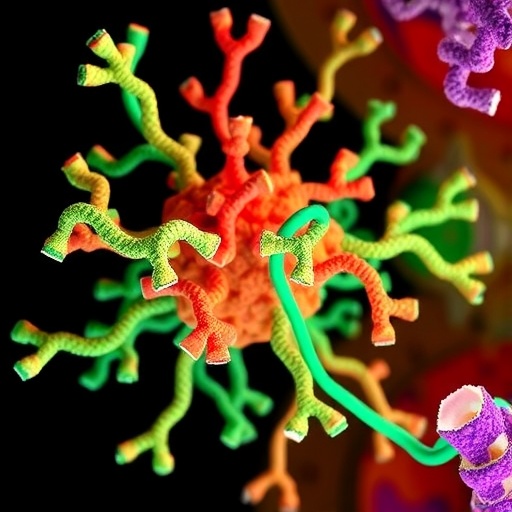
Researchers at Kyushu University in Fukuoka, Japan, have made a groundbreaking discovery in the realm of endocrinology, particularly concerning aldosterone-producing adenomas (APAs), which are benign tumors found in the adrenal glands responsible for the production of aldosterone, a hormone linked to the regulation of blood pressure. This innovative study harnesses advanced multiomics techniques to illuminate the intricate cellular architecture of APAs, revealing that these tumors are not a uniform mass but a composite of at least four distinct cell types, including those that produce cortisol, the body’s primary stress hormone. Being able to view these tumors through a new lens amplifies our understanding of the variable health outcomes associated with APAs, including the unexpected complications such as bone fragility experienced by some patients.
The primary author of the study, Assistant Professor Maki Yokomoto-Umakoshi, underscores the historical stagnation regarding treatment options for APAs, as surgical intervention has been the sole method of addressing these tumors for decades. Given that APAs significantly contribute to primary aldosteronism—a condition responsible for about 5% to 10% of all high blood pressure cases—this new knowledge could not only help to elucidate the underlying mechanisms that allow for the diverse health issues stemming from APAs but also pave the way toward the development of innovative therapeutic strategies.
The adrenal glands, situated atop the kidneys, synthesizes critical hormones, including aldosterone and cortisol, making APAs a critical area of study. High blood pressure due to APAs is not only a health concern in its own right; it also predisposes patients to severe cardiovascular issues, diabetes, and bone weakening. Such serious outcomes highlight the necessity for profound research into APAs, particularly focusing on how these tumors behave and interact on a cellular level.
Focusing specifically on tumors linked with mutations in the KCNJ5 gene, which are implicated in approximately 40 to 70% of APA cases, the research team delves into the cellular makeup and hormonal production of these tumors. These KCNJ5 mutations are associated with larger tumors typically manifesting at a younger age, presenting far more severe symptoms than isolated aldosterone overproduction can explain. This insight has opened an avenue toward understanding the uncertainty surrounding the elevated risks associated with KCNJ5-linked APAs, finely tuning therapeutic approaches toward this specific genetic mutation.
Introducing innovative multiomics analysis techniques, the researchers were able to intricately map the spatial distribution of different cell types within these tumors. This pioneering approach provided an unprecedented clarity regarding cellular interactions within the tumor microenvironment. By discerning how various cell types influence one another and the overall tumor landscape, the team illuminated several hitherto obscure pathways underlying tumor development and function.
Among the four distinct cell types identified, the study emphasized the presence of cells that respond to stress, which then differentiate into either aldosterone or cortisol producers. Additionally, the research illustrated that cortisol-producing cells have the potential to evolve into stromal-like cells, contributing to tumor growth—this unique complexity indicates an adaptable cellular ecosystem within APAs, warranting further exploration into these dynamic interrelations.
An intriguing finding was the prevalence of lipid-associated macrophages—a specific kind of immune cell—within the tumor microenvironment. This suggests they may play an influential role in modulating hormone secretion and promoting tumor growth, which begs the question of whether these macrophages could serve as viable targets for future therapeutic strategies. The implications of targeting specific immune cell populations signify a potential shift in treatment paradigms, moving away from purely surgical options toward more targeted pharmaceutical interventions.
Overall, the findings underscore the possibility that APAs represent a spectrum of hormone-producing cell types capable of eliciting various health symptoms beyond elevated blood pressure, including complications driven by excess cortisol. This multifaceted nature of APAs highlights the necessity for a tailored therapeutic approach that addresses not just aldosterone overproduction but also the additional hormonal byproducts with clinical relevance.
In the context of public health, these revelations are essential for crafting prevention and management strategies. Increased awareness around APAs and their multifarious effects on patient health should catalyze more robust screening and diagnostic strategies, potentially leading to early interventions that could mitigate the severe health consequences associated with untreated APAs.
As the research team charts a path forward, they plan to broaden the scope of their investigation to encapsulate other APA types and hormonal tumors, with the hope that enhanced understanding of cellular ecosystems will facilitate the discovery of groundbreaking drug treatments. The future of APA treatment may not only hinge on traditional pathways like surgical removal but also explore the relentless potential of pharmacological advancements aimed at specific cellular mechanisms.
Ultimately, the study acts as a beacon of hope for the countless individuals affected by APAs. It not only augments current medical knowledge around these tumors but also lays the groundwork for promising new treatment modalities that may significantly improve patient outcomes, emphasizing the continued importance of fundamental research in advancing clinical practice and patient care.
As we draw insights from these multifaceted findings, the medical community may soon witness a paradigm shift in how we understand and manage APAs, reminding us that the intricate dance of cellular biology continues to intrigue and inspire future scientific endeavors.
Subject of Research: People
Article Title: Multiomics analysis unveils the cellular ecosystem with clinical relevance in aldosterone-producing adenomas with KCNJ5 mutations
News Publication Date: 24-Feb-2025
Web References:
References:
Image Credits:
Keywords: Aldosterone-producing adenomas, Kyushu University, KCNJ5 mutations, cortisol, multiomics analysis, primary aldosteronism, cardiovascular health, targeted therapy.
Tags: adrenal gland tumors researchadvancements in adrenal gland researchaldosterone-producing adenomas studybone fragility in adrenal tumor patientscellular architecture of APAscomplications of adrenal tumorscortisol-producing cell typesFukuoka University endocrinology discoverieshealth outcomes associated with aldosteroneinnovative treatment options for APAsmultiomics techniques in endocrinologyprimary aldosteronism and hypertension





